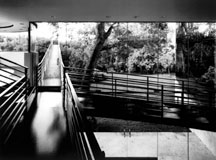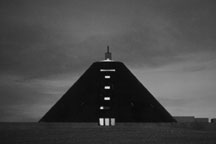

Sky ramp of the Turtle Creek House, Dallas, Texas, 1993 and American Heritage Center and Art Museum, University of Wyoming, Laramie, 1993. |
Going back to the earth and sky, these are things that inevitably we sense very strongly in the southwest because of the way the landscape is formed and the poignant longing for the bridging of the earth and sky. In the Turtle Creek House in Dallas, there is a sky ramp that soars to the sky; the only limitation would be your own imagination in terms of how you would fully exploit that sky trajectory. Being in the ground, hunkering back into the earth, is a primitive response that so many of us have. Going into a ‘cosy’ protective place. But then the aspiration to the sky to me is that of the dynamic of soaring, the escape of ideas and spirit to the sky, the diffusion of energy to the sky.
GHB: I was at the American Heritage Center and Art Museum
at Laramie and sensed everything you’ve just been talking about,
particularly the cosiness of the cone-shaped form and then the sense of
liberation when you’re on the terrace. So you get these two extremes:
when you’re inside, you have the symbol of the chimney penetrating
right down through the building, and on the other hand you have the terrace.
I walked out there at sunset; the moon was up, and the cone shape was
seen in an almost fiery light. One sensed throughout that building, as
I think one does in all your buildings, a theme of contact. You’ve
mentioned contact with the earth and the sky and at Laramie there’s
a special contact with the landscape as you enter the building. You’re
given glimpses of the mountains to the east, and in the entry foyer; there’s
a glimpse of the sky through the way the strands of the structure allow
light to come in there. So I did sense exactly what you’re saying
and I felt a tremendous tension between the forms as well, that the one
was a swirling cone that was full of its own energy through the distortion
of its shape and the way that the struts on the eastern side allow one
kind of contact. On the western side you place windows on the lower part
of the building that are deeply inset so that they seem to be watching
almost furtively. Certainly there’s a strong feeling of protection,
in that building, in the cone.
AP: The connectedness of the building occurred in different ways. In your explanation, the operations of connecting to the land and sky were well articulated. The building was envisaged as a silhouette. At a distance the Heritage Center appears as a new mountain, a new archival mountain. In my work, all around the edges, and in the centre at various times, I have tried to make buildings that project the sense of a surrogate landscape, a sense of abstraction of the mesa, the mountain. It’s a centralised hearth conjuring up the almost cartoon image of the glowing window on a winter night projecting a ray of light on the snow. The enigmatic quality of that welcoming indication of arrival in a building is important to me. Although the building is mainly about isolation, views towards the distant landscape are organised to selectively choose particular vantage points. Light becomes very important. Where the light is the morning light, particularly in the winter, this invitation is on the east side. You’ve referred to the structural members fanning their way through that glazing system. It’s as open as we could make it to allow maximum light penetration, creating views of the sky that were all-encompassing compared with the individual view fragments in the rest of the apertures at the front. So the notion of connection is critical, and it occurs at many levels. It occurs from airplanes, and from the car coming down the Interstate Highway. The building to me suggests, in its evolving copper patina, an ancient helmet erupting from the prairie. The work isn’t intended though to merely evoke an ancient source. If that comes along and to be lucky enough for certain viewers like yourself, to respond to, that’s fantastic. It is not something I can formulate. It’s there or it isn’t.